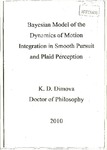Bayesian model of the dynamics of motion integration in smooth pursuit and plaid perception
| dc.contributor.supervisor | Wennekers, Thomas | |
| dc.contributor.author | Dimova, Kameliya | |
| dc.contributor.other | School of Engineering, Computing and Mathematics | en_US |
| dc.date.accessioned | 2010-11-01T08:33:48Z | |
| dc.date.available | 2010-11-01T08:33:48Z | |
| dc.date.issued | 2010 | |
| dc.date.issued | 2010 | |
| dc.identifier | 10082826 | en_US |
| dc.identifier.uri | http://hdl.handle.net/10026.1/290 | |
| dc.description.abstract |
In this thesis, a model of motion integration is described which is based on a recursive Bayesian estimation process. The model displays a dynamic behaviour qualitatively similar to the dynamics of the motion integration process observed experimentally in smooth eye pursuit and plaid perception. The computer simulations of the model applied to smooth pursuit eye movements confirm the psychophysical data both in humans and monkeys, and the physiological data in monkeys. The temporal dynamics of motion integration is demonstrated together with its dependence on contrast, size of the stimulus and added noise. A new theoretical approach to explaining plaid perception has been developed, based on both the application of the model and a novel geometrical analysis of the plaid’s pattern. It is shown that the results from simulating the model are consistent with the psychophysical data about the plaid motion. Furthermore, by formulating the model as an approximate version of a Kalman filter algorithm, it is shown that the model can be put into a neurally plausible, distributed recurrent form which coarsely corresponds to the recurrent circuitry of visual cortical areas V1 and MT. The model thus provides further support for the notion that the motion integration process is based on a form of Bayesian estimation, as has been suggested by many psychophysical studies, and moreover suggests that the observed dynamic properties of this process are the result of the recursive nature of the motion estimation. | en_US |
| dc.language.iso | en | en_US |
| dc.publisher | University of Plymouth | en_US |
| dc.subject | Bayesian | |
| dc.subject | Computational model | |
| dc.subject | Eye pursuit | |
| dc.subject | Plaid perception | |
| dc.subject | Perception | en_US |
| dc.title | Bayesian model of the dynamics of motion integration in smooth pursuit and plaid perception | en_US |
| dc.type | Thesis | |
| dc.identifier.doi | http://dx.doi.org/10.24382/4730 |
Files in this item
This item appears in the following Collection(s)
-
01 Research Theses Main Collection
Research Theses Main


